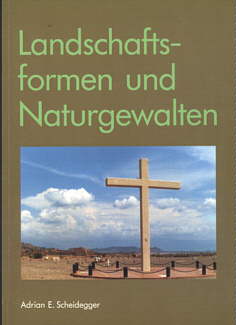
Naturgewalt: In Folge eines Ausbruches des 5300 m hohen Vulkans Nevado de Ruiz (Columbia) am 13. November 1985 wurde dessen Eiskappe grösstenteils sehr rasch abgeschmolzen. So ergossen sich riesige Wassermassen die Täler hinunter, welche Schlamm, Felsblöcke und Schutt mitrissen und dadurch zu gewaltigen vulkanischen Murgängen («Lahars») wurden. Die Stadt Armero wurde an jenem Tage verschüttet; in ihr kamen 22 000 Leute ums Leben. Das grosse Kreuz zeigt den ehemaligen Standort der Kirche an, die (Tausende) kleinen Kreuze wurden von Angehörigen an den Stellen der ehemaligen Heimstätten der Toten, unter denen sie begraben liegen, errichtet. Die Gegend bietet auch heute noch den Anblick totaler Verwüstung (Aufnahme des Verfassers vom 25. Februar 1988).
Zusammenfassung
Die Arbeit zeigt die Ursache der Landschaftsentwicklung,
die in der Wirkung von natürlichen Prozessen liegt, die oft von Menschen
als «Naturgewalten» empfunden werden. Grundsätzlich wirken
zwei Typen von Prozessen: die endogenen, die ihren Ursprung in der Tektonik
haben, und die exogenen, deren Ursprung in der Atmosphäre liegt. Die
antagonistische Wechselwirkung dieser zwei Arten von Prozessen produziert
sowohl Landschaften wie auch Naturkatastrophen.
Es werden zuerst Landschaften und Naturgewalten, die
primär endogenen Ursprungs sind, besprochen, und anschliessend diejenigen,
die primär exogen bedingt sind.
Schliesslich führt die Synthese der beiden Arten
von Prozessen auf die allgemeinen Prinzipien der Landschaftsentwicklung,
die in einer «Systemtheorie» der Landschaften und Naturgewalten
kulminiert.